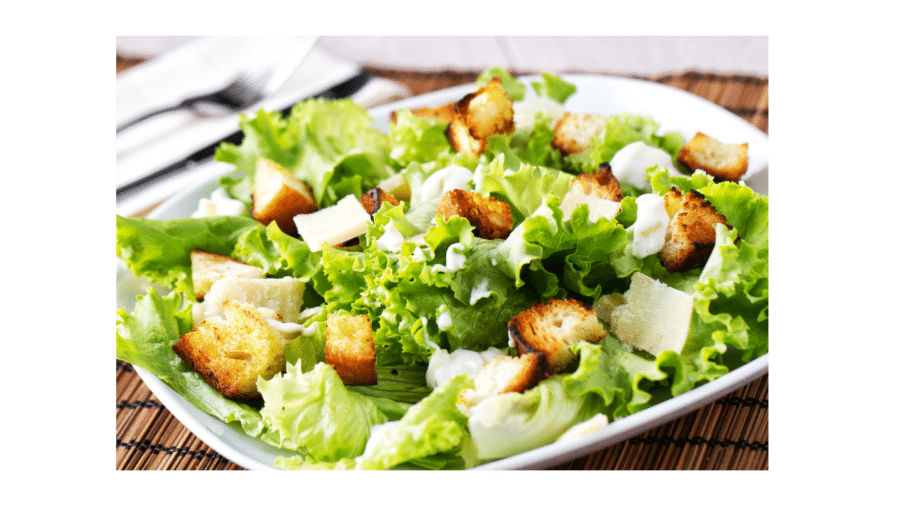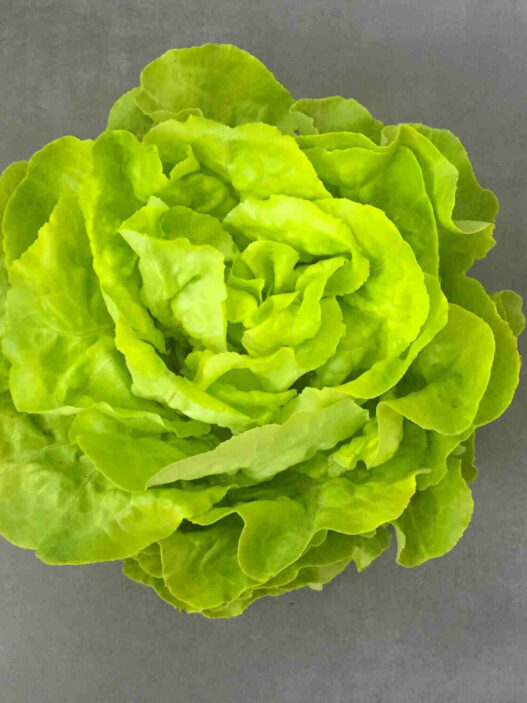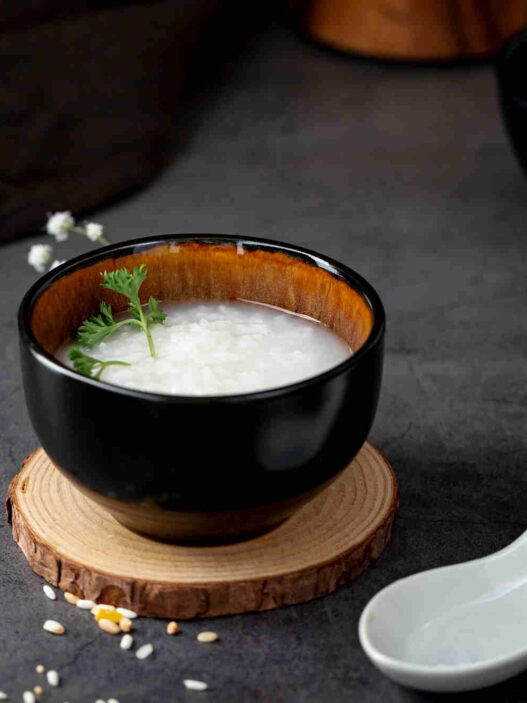Cos lettuce, also known popularly as Romaine lettuce, is a type of lettuce that is known for its crisp texture and slightly bitter flavor. It is known as Cos Lettuce as it originated in the Greek island called Kos. It is a member of the Lactuca sativa family (Lactuca sativa L. var. longifolia), which also includes other types of lettuce such as Butterhead and Iceberg. Check out the health benefits and risks, the Parris island cos lettuce variety, and the butter lettuce vs romaine difference. Cos lettuce is known for its long, crisp leaves and slightly bitter flavor. It is often used in salads and as a garnish. It has a very high-water content and only a few calories. One of the most popular uses of Romaine lettuce is in Caesar salad, where it provides a crispy and slightly bitter base that complements the creamy dressing, Parmesan cheese, and croutons.
Appearance/ Shape/ Texture/ Color of Romaine/ Cos Lettuce
Romaine lettuce is characterized by its long, narrow leaves that are typically a bright green color. The leaves are crisp and have a slightly bitter taste. The thick ribs of Cos lettuce on the outer side have milky fluid. The flavor of Cos lettuce is more robust and nuttier than other types of lettuce, making it a good choice for salads, sandwiches, and garnish.
Some unique characteristics of this type of lettuce include:
Crunchy Texture
It is known for its crunchy texture and is often considered one of the crunchiest types of lettuce.
Tall, Erect Head
Cos lettuce has a tall, elongated head that stands upright, making it easy to chop and use in a variety of dishes.
Nutty Flavor
The flavor of Cos lettuce is often described as nutty and slightly sweet, making it a popular choice for salads and sandwiches.
High in Nutrients
Cos lettuce is a rich source of vitamins A, C, and K, as well as dietary fiber and potassium.
Versatile Use
Romaine lettuce can be used in a variety of dishes, such as salads, sandwiches, and wraps. It can also be grilled or roasted for a delicious and unique addition to any meal.
Nutrition and Health Benefits of Romaine/ Cos Lettuce
Cos lettuce is a good source of Vitamin K, Vitamin A, and Vitamin C. It also contains a variety of minerals, antioxidants, and other beneficial compounds that can support overall health.
Some of the bioactive constituents of lettuce include (1):
Phenolic acid compounds
Phenolic acid compounds include Flavonoids (Quercetin glycosides, Kaempferol glycosides) and Flavones (Luteolin). The most abundant polyphenols in Cos lettuce are caffeic acid and p-coumaric acid.
Lutein and Beta carotene
Other than the above, Cos lettuce contains Apigenin, Anthocyanins, and Carotenoids such as Lutein, and beta-carotene. It is to be noted that the Cos or Romaine variety of Lettuce has the highest content of Lutein and beta-carotene as compared to other lettuce varieties. The crisp head lettuce, on the other hand, contains the lowest Lutein and beta-carotene content. Lutein has antioxidant and anti-inflammatory properties and is mainly popular for its beneficial effects on eye health but also improves cognition and is heart healthy.
Sesquiterpene lactones
Romaine lettuce contains Sesquiterpene lactones (Lactucin, Lactucopicrin) – These are linked to bitterness and romaine lettuce has slightly more of these lactones.
Vitamins
Vitamin B9 (Folate)
Cos lettuce also contains Folate (Vitamin B9) and other vitamins as mentioned below.
Vitamin C (Ascorbic acid)
Cos lettuce is a good source of vitamin C and contains higher levels of vitamin C as compared to other varieties. Stem-type lettuce has even higher levels. Vitamin C help boost the immune system.
Vitamin E (Tocopherol)
Cos lettuce is known to contain the highest alpha-tocopherol levels as compared to other lettuce varieties.
Vitamin K (Phylloquinone)
Cos Lettuce is a good source of Vitamin K. Romaine lettuce, along with other lettuce varieties such as Looseleaf and Butterhead, is an excellent source of dietary Phylloquinone. Not only does vitamin K help decrease the risk of bone fractures but also helps in blood coagulation. Further, vitamin K is also important for protecting us against cardiovascular diseases.
Other health benefits of Romaine/ Cos Lettuce
Sleep Inducer
Scientists studied in the experimental mice that the polyphenols present in Cos lettuce potentiated drug-induced sleeping behavior and hence Romaine lettuce may be explored further for its antioxidant and sleep-potentiating potential (2).
Good for Diabetes
A study reported the calming effect of Cos or Romaine Lettuce and that it helped manage glycaemic control. The study concluded that adding such leafy greens may improve postprandial metabolism (3).
Side effects of Cos Lettuce & Risk of E.coli Outbreaks
Though there are several beneficial effects of Cos lettuce, there are also downsides to it as Romaine lettuce has been linked to the cause of a large number of outbreaks of Escherichia coli or E. coli infection in Canada between 2008 to 2018.
During this period, 11 outbreaks were reported due to leafy greens and 7 of them were linked to Romaine or Cos lettuce and only 2 to Iceberg lettuce (4). Thus, commercially available Cos/ Romaine lettuce contains several warnings by Health authorities on its susceptibility to being contaminated by E.coli.
Cos Lettuce Varieties
The popular varieties of Cos lettuce are – Cimarron, Little Caesar, Little Gem, Parris Island, Paris White, and Vivian.
Parris Island Cos Lettuce or Romaine Lettuce Variety
Parris Island Cos lettuce or Romaine lettuce is a variety of lettuce that is prized for its crunchy texture and sweet, nutty flavor.
Parris island cos lettuce is a type of Romaine lettuce, named after the famous Parris Island military training base in South Carolina, USA. This lettuce is known for its elongated head with crisp leaves that are dense and hold well in the center.
It is often used in salads and sandwiches, or as a wrap for fillings. Parris Island Cos lettuce is considered one of the tastiest varieties of Romaine lettuce and is a popular choice among home gardeners or professional growers for its taste and ease of cultivation.
Availability and Storage
Romaine lettuce is generally available year-round, but it is at its peak during the spring and fall months. It is best stored in a plastic bag in the refrigerator and should be used within a few days of purchase to ensure that it stays fresh. Romaine lettuce is available as heads or in a packed salad mix.
Even while transporting, it is recommended to store Romaine lettuce at a temperature of 0-5֯ C and refrigerated it at all times. This also minimizes the growth of pathogens like E. coli and keeps it fresh.
It is tolerant to heat, unlike other lettuce.
When purchasing Romaine lettuce, look for heads that are firm and have crisp, dark green leaves. Avoid heads with wilted or yellowing leaves, as they are past their prime.

Butter Lettuce vs Romaine Lettuce
When it comes to knowing the difference between Butter lettuce vs Romaine lettuce, there are significant differences between the two lettuce varieties. Here is a summary of how butter lettuce vs romaine lettuce compares.
Butter lettuce vs Romaine lettuce – Texture and Shape of Leaves
While butter lettuce has a buttery texture, Romaine lettuce has a crisp texture.
Leaves of butter lettuce are spherical while they are long narrow leaves for Romaine lettuce.
Butter lettuce vs Romaine Lettuce – Differences in Nutrition
Nutrition-wise, Romaine lettuce contains Lutein and beta carotene and higher vitamin C levels compared to the Butter lettuce variety. It also contains higher alpha-tocopherol as compared to butterhead lettuce.
Conclusion
Cos/ Romaine lettuce is the most common lettuce popularly added to Caesar salad. Though it has high nutritional value and is full of vitamins (C, E & K) and other antioxidant compounds, it carries the risk of E. coli infection if not used fresh. Overall, Cos lettuce is a unique and delicious variety of lettuce that is valued for its crisp texture, sweet flavor, and high nutrient content.
Sources











